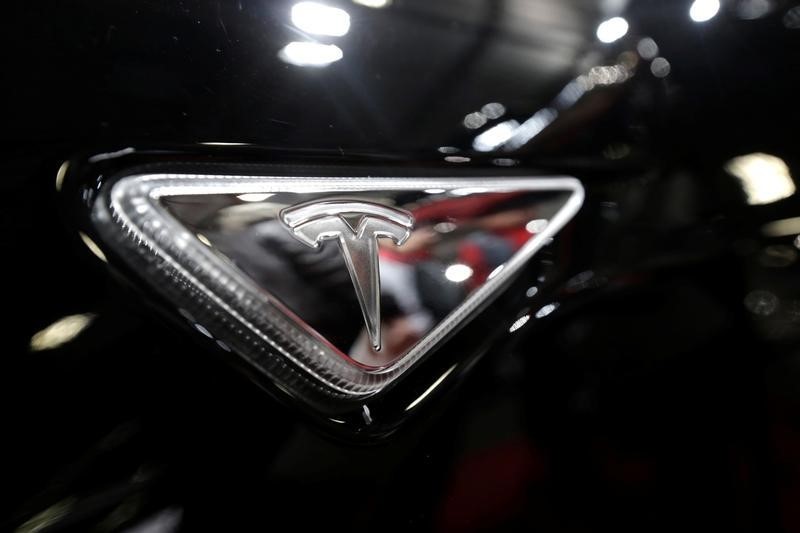This post was originally published on this site
https://i-invdn-com.investing.com/trkd-images/LYNXMPEK3T0VU_L.jpg
DETROIT (Reuters) -Elon Musk’s abrupt decision to lay off employees who ran Tesla (NASDAQ:TSLA)’s electric vehicle charging business blindsided automakers gearing up to equip new EVs for customers to use the Tesla Supercharger network, industry officials and analysts said on Tuesday.
For now, General Motors (NYSE:GM), Ford (NYSE:F) and other automakers which struck deals last year to give customers access to the network said they are not changing their plans.
Tesla’s decision to open its network to rival EV manufacturers was hailed by U.S. President Joe Biden, and opened the door for Tesla to get federal subsidies to expand the reach of its North American Charging Standard (NACS) system.
Musk’s decision to dismiss the head of the business, Rebecca Tinucci, and most or all of the staff that operated and maintained the system, according to two former employees and multiple postings on LinkedIn, left officials at automakers and Tesla suppliers uncertain about the future.
Tesla did not respond to requests for comment.
Musk subsequently said on X that the carmaker still plans to expand the Supercharger network, “just at a slower pace for new locations and more focus on 100% uptime and expansion of existing locations.”
Andres Pinter, co-CEO of Bullet EV Charging Solutions, a supplier to the network, said, “As contractors for the Supercharger network, my team woke up to a sharp kick in the pants this morning.”
“Tesla has already been awarded money under the federal government’s NEVI program,” he said, referring to the National Electric Vehicle Infrastructure formula program to provide funding to states to deploy EV charging networks. “There’s no way Mr. Musk would walk away from effectively free money. It may be possible Mr. Musk will reconstitute the EV charger team in bigger, badder, more Muskian way.”
GM and Ford, in separate statements, said they are not changing plans to equip their EVs with connectors that will allow drivers of Chevrolet, Cadillac or Ford brand EVs to recharge at Tesla stations.
“We have nothing new to announce regarding our plans,” GM said. “We are continuing to monitor the situation regarding changes to the Supercharger team and the potential impacts with no further comments or updates at this time.”
‘NOTHING IS OFF THE TABLE’
Some industry executives and analysts said Musk could have disbanded the existing Supercharger organization to build a leaner and less expensive team to run the operations.
However, Musk made clear in a call with analysts earlier this month that he is focused on opportunities in artificial intelligence, robotics and autonomous robotaxis.
“In this layoff, nothing is off the table,” Wedbush Securities analyst Dan Ives said. “Musk is trying to send a signal internally that the difficulty that Tesla is going through, they’re going to have to make tough decisions. … It shows there is serious cost focus.”
Tesla last week reported lower first-quarter profits and its first quarterly revenue decline since 2021. Even after a surge over the past week, Tesla shares are down about 26% for the year.
In China, the company’s second-biggest market to which Musk made a surprise weekend visit to discuss a potential roll-out of its advanced driver-assistance package, Tesla has more than 1,350 Supercharger stations, according to a list on its website.
With sales of Tesla’s EVs falling and profit margins under increasing pressure, Musk could be cutting Supercharger network spending to conserve cash for other projects with more growth potential, analysts said.
“Tesla is looking to right size its (capital spending) and operating expenses over the next couple of years as the company is in a slower growth phase,” Morningstar analyst Seth Goldstein said.
More traditional automakers might hang on to a business that promised steady revenue and near-continuous data exchanges with customers, analysts said. But Musk could take a Silicon Valley entrepreneur’s view that charging is a legacy business that could be streamlined or even divested.
“My guess is that now that the industry has adopted the NACS standard, he views Supercharging less as a strategic moat and more as a cost center,” said KC Boyce, a vice president at data analytics firm Escalent.
The Tesla Supercharger network could have significant value if Musk wanted to sell it, analysts said. Rival U.S. charging networks have struggled with reliability problems and do not have the scale or prime locations Tesla has locked in.
Seven large automakers, including Mercedes, GM, Stellantis (NYSE:STLA), Honda (NYSE:HMC), BMW (ETR:BMWG) and Hyundai-Kia last year formed a joint venture called Ionna to develop a fast-charging network to compete with the Tesla Supercharger network.

